#pilafi
Text
realized it´s been four years since I attended a wedding
#I miss you rice throwing I miss you outfit rating#I miss you sticky pilafi I miss you evil synthesizer I miss you random kids dancing alone on the stage
6 notes
·
View notes
Text
Cypriot Afelia Cooked Pork With Pourgouri Pilaf At A Birthday Dinner
🥘🍚

Cypriot Afelia Cooked Pork with Pourgouri Pilaf at a Birthday Dinner - Kypriaka Afelia me Pourgouri Pilafi kai Deipno Genethiwn
BY: Greek Cooking Made Easy
SUBSCRIBE TO MY YOUTUBE CHANNEL: https://www.youtube.com/greekcookingmadeeasy
Check My YouTube Video: HERE
Κοιτάξτε Επίσης Την Συνταγή Μου Σε YouTube Βίντεο, Το Λίνκ Είναι: ΕΔΩ
youtube
SERVES 🍴⃒ PREP. TIME 🕔⃒
4-5 pers. Afelia: 10 min. + 4-5 h wait
Pourgouri: 5 min.
COOK. TIME ♨ DIFFIC. LEVEL 👩🍳⃒
Afelia: 1 h Easy
Pourgouri: 10 min.
Afelia is a traditional, simple Cypriot dish of pork pieces first marinated, then sautéed, deglazed with dry red wine and coriander seeds and boiled for a long time.
The name comes from the ancient Greek word 'obelos' or 'obelia'= avelia, i.e. similar to meat on a spit.
Afelia is usually accompanied by Pourgouri pilaf or "antinahtes" potatoes and yogurt.
Pourgouri or purkurin is the Cypriot name for bulgur. Pourgouri Pilaf is an easy and quick dish to prepare and accompanies many other dishes of meat or chicken, although it is best known for serving with Afelia.
Enjoy my double recipe today while I give you ideas on how to serve them with other delicacies for a wonderful birthday dinner or any special occasion at home.
INGREDIENTS
Ingredients for the Afelia:
· 1 kg. / 2.25 lb boneless Pork chops, in semi-large cubes (from either shoulder or neck)
· 2 Garlic Cloves, finely chopped
· 1/3 cup / 80 ml Olive Oil
· 2-3 Bay leaves
· 1 cup / 250 ml dry Red Wine
· 2 tbsp. Coriander seeds
· Optional: 1 tbsp. fresh Parsley, finely chopped (to garnish)
· Ground Salt and Pepper
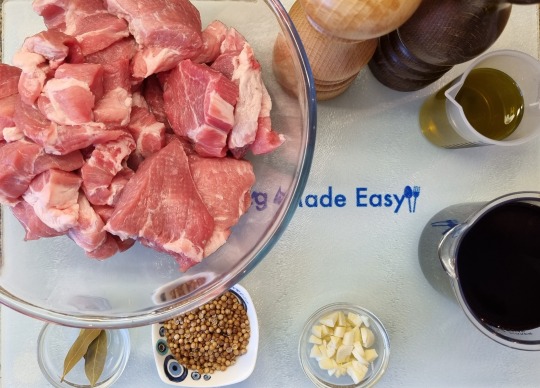
Ingredients for the Pourgouri Pilaf:
· 1.4 cups / 300 gr. / 10.5 oz Bulgur
· 1/3 cup / 50 gr. / 1.75 oz / about 1.5 nests Fine Coiled Vermicelli Pasta (fine fide or fideo pasta, in small pieces)
· 4 tbsp. / 60 ml Extra Virgin Olive Oil
· 3 cups / 750 ml Hot Water
· 1/2 cup / 125 ml broth-juice from cooking Afelia
· Ground Salt and Pepper
· Optional: 1 tbsp. Tomato paste-puree (for more authentic recipe)
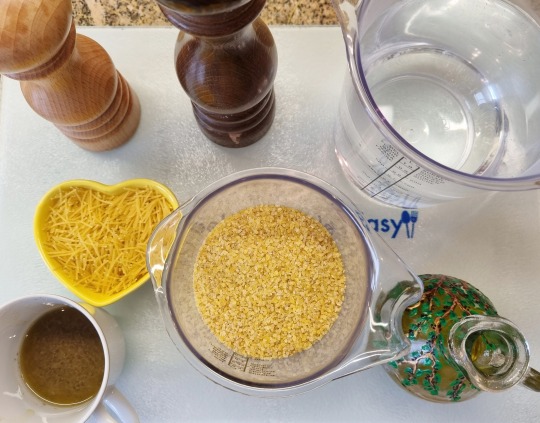
METHOD:
A. Marinade the meat the night before:
1. It is generally advised to marinate the meat for at least 4-5 hours or all night in order to absorb the marinade and be more tasty.
2. Place the pork cubes in a large glass bowl.
3. Coarsely crush the coriander seeds using mortar and pestle.
4. Sprinkle 1/2 of them on top of the meat. Reserve the rest.
5. Then pour in 3/4 of the red wine.
6. Add also the chopped garlic and bay leaves.
7. With your hands mix all marinade ingredients very well.
8. Cover the tray with plastic wrap and place in the fridge (until the following day, if possible).
B. Cook the Afelia earlier on the day of serving:
9. Take the bowl with marinated meat out of the fridge 1 h before cooking.
10. Pour the olive oil in a deep pot over high heat.
11. When it heats up, add the pork cubes together with their marinade in the pot.
12. Sauté the meat for a couple minutes, stirring regularly.
13. Or for a lighter dish (like I did), deglaze directly by adding rest of wine and 1/2 from the reserved, crushed coriander seeds. Stir to blend them in (don’t add any seasoning now!).
14. Reduce heat to very low, place the lid on top of the pot and let meat simmer for 1 hour or until very tender. Halfway through, you may need to add 1/2 cup water.
15. Tip: For a quicker, energy efficient boiling time, use a pressure cooker, and boil meat for 30'. With this option, you won't need to add any water.
16. Remove the lid and try the meat. Afelia is ready when the meat falls apart from the fork and the sauce is thick and aromatic. If it’s not fork tender, add a bit extra hot water and let it boil some more.
17. Season with ground Salt and Pepper, to taste and add the rest of coriander seeds. Stir to blend them in and turn off the heat.
18. Let the stew cool down for 10'.
19. With a ladle, collect 1/2 cup of the sauce (broth). That will be used to give extra flavour to the pilaf.
20. Reserve the pot with Afelia covered with lid.
C. Make the Pourgouri Pilaf just before serving:
21. Note: Pourgouri Pilaf is traditionally prepared with fide pasta and tomato paste. I opted not to use tomato paste but you could certainly add it, if you prefer.
22. Pour the olive oil in a wide pot over high heat.
23. When it heats up, reduce heat and add the fide pasta. Sauté it for a couple min or until it browns, stirring continuously.
24. Next, add the bulgur. Sauté it together with the fide for 2’ or until it shines. At this point, you can also add the tomato paste (if using) and sauté it for a couple of min. to release its aromas.
25. Pour in the hot water and season with Salt and ground Pepper, to taste. Pour in the broth from Afelia as well. Stir to blend them in.
26. Place the lid on top of the pot and let bulgur simmer for approx. 10’ (check instructions on the package).
27. Note: Without lid, boiling should take about 20’ and needs probably some extra BOILED water. Pourgouri should stay a bit grainy when you eat it.
28. Warm up Afelia just before serving.
29. After about 10', Pourgouri should be ready. Remove from heat.
30. Replace the lid with a clean kitchen towel. Leave it for 10’-15’, so that the towel will absorb the humidity. Remove towel just before serving and mix with fork again to fluff it up and serve.
D. Serving Suggestion:
Serve Pourgouri Pilaf, still hot, in a deep bowl. Look how appetising it is!

Serve scrumptious Afelia very hot, garnished with some fresh, chopped parsley on top! The meat is fork tender in a thick slightly sweet and sour sauce with the characteristic flavor of coriander i.e. floral as cardamom, nutty, full of citrus and curry, light and sweet (the broken seeds are fun to crunch on, as well).

They make quite an extraordinary pairing together with lots of bread to sop up the luscious sauce! A glorious, comfort, umami dish!
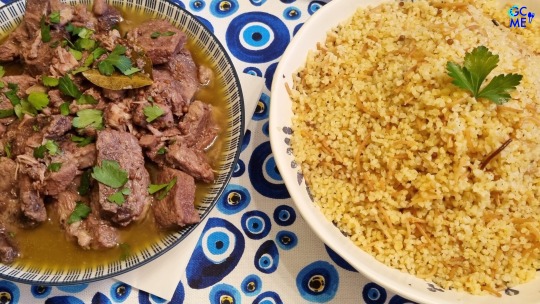
For example, I served them for my Daughter Melissa's birthday with: Hummus with yoghurt and Avocado (instead of plain yoghurt), Fava, Lettuce Salad, Olive Bread, Pasta Flora, Black Forest Birthday Cake and red Wine.



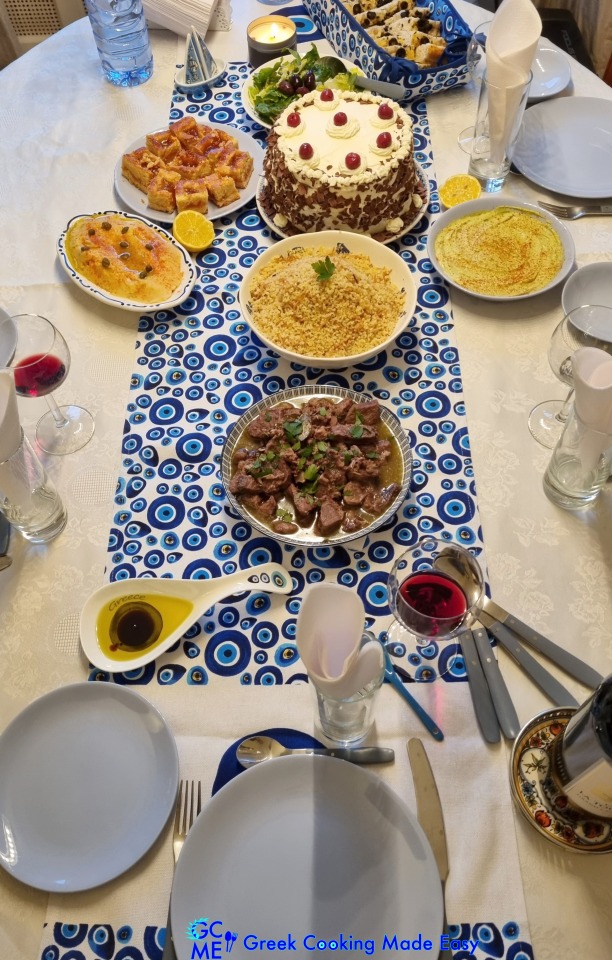
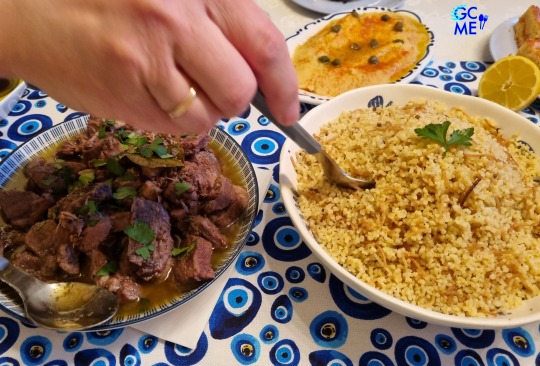
Bon Appetit-Kali Orexi!
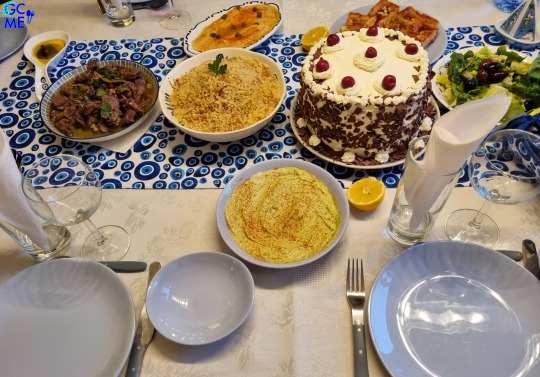

E. Storage Info:
Afelia can be stored, in an airtight container, in the fridge for up to 1 week or in the freezer for 1 month. Pourgouri can be stored, in an airtight container, in the fridge for up to 1 week.

Check my YouTube Video: HERE

Κυπριακά Αφέλια με Πουργούρι Πιλάφι και Δείπνο Γενεθλίων
BY: Greek Cooking Made Easy
SUBSCRIBE TO MY YOUTUBE CHANNEL: https://www.youtube.com/greekcookingmadeeasy
ΜΕΡΙΔΕΣ🍴⃒ ΠΡΟΕΤΟΙΜΑΣΙΑ 🕔⃒
4-5 Αφέλια: 10 min. + 4-5 h αναμονή
Πουργούρι: 5 min.
ΜΑΓΕΙΡΕΜΑ ♨ ΒΑΘΜ. ΔΥΣΚΟΛΙΑΣ 👩🍳⃒
Αφέλια: 1 h Εύκολα
Πουργούρι: 10 min.
Τα Αφέλια είναι ένα παραδοσιακό, εύκολο Κυπριακό πιάτο με κομμάτια χοιρινού πρώτα μαριναρισμένα, μετά τσιγαρισμένα, σβησμένα με κόκκινο ξηρό κρασί και σπόρους κόλιανδρου και βρασμένα για πολλή ώρα.
Το όνομα προέρχεται από την αρχαία Ελληνική λέξη «όβελος» ή «οβελία» = αβέλια, δηλαδή παρόμοιο με κρέας στη σούβλα.
Τα Αφέλια συνοδεύονται συνήθως με πουργούρι πιλάφι ή «αντιναχτές» πατάτες και γιαούρτι.
Πουργούρι ή πουρκούριν ονομάζεται το πλιγούρι στα Κυπριακά. Το πουργούρι πιλάφι είναι ένα εύκολο και γρήγορο πιάτο στην ετοιμασία και συνοδεύει πολλά άλλα πιάτα με κρέας ή κοτόπουλο, αν και είναι περισσότερο γνωστό σαν συνοδευτικό για Αφέλια.
Απολαύστε σήμερα τη διπλή συνταγή μου ενώ σας δίνω ιδέες για το πώς να τα σερβίρετε με άλλες λιχουδιές για ένα υπέροχο δείπνο γενεθλίων ή οποιαδήποτε σπέσιαλ περίσταση στο σπίτι.
ΥΛΙΚΑ
Υλικά για τα Αφέλια:
• 1 κιλό / 2,25 lb Χοιρινές μπριζόλες χωρίς κόκαλο, σε μεσαίους κύβους (είτε από τη σπάλα ή λαιμό)
• 2 Σκελίδες Σκόρδο, ψιλοκομμένες
• 1/3 φλ. / 80 ml Ελαιόλαδο
• 2-3 φύλλα Δάφνης
• 1 φλ. / 250 ml κόκκινο Κρασί, ξερό
• 2 κ.σ. Σπόροι Κόλιανδρο
• Προαιρετικά: 1 κ.σ. Μαϊντανός ψιλοκομμένος (για γαρνίρισμα)
• Φρεσκοαλεσμένο αλάτι και πιπέρι

Υλικά για το Πουργούρι Πιλάφι:
• 1,4 φλ. / 300 γρ. / 10,5 oz Πλιγούρι
• 1/3 φλ. / 50 γρ. / 1,75 oz / περίπου 1,5 φωλιά Φιδές σε μικρά κομμάτια
• 4 κ.σ. / 60 ml Εξαιρετικό Παρθένο Ελαιόλαδο
• 3 φλ. / 750 ml Ζεστό Νερό
• 1/2 φλ. / 125 ml ζωμός από το μαγείρεμα των Αφέλια
• Φρεσκοαλεσμένο αλάτι και πιπέρι
• Προαιρετικά: 1 κ.σ. Τοματοπελτές (για τη πιο αυθεντική συνταγή)

ΜΕΘΟΔΟΣ:
Α. Μαρινάρετε το κρέας το προηγούμενο βράδυ:
1. Γενικά συνιστάται να μαρινάρετε το κρέας για τουλάχιστον 4-5 ώρες ή όλο το βράδυ για να απορροφηθεί η μαρινάδα και να σας γίνει πιο νόστιμο.
2. Τοποθετήστε τους κύβους χοιρινού σε ένα μεγάλο γυάλινο μπολ.
3. Σπάστε σε χοντρά κομμάτια τους σπόρους κόλιανδρου χρησιμοποιώντας γουδί και γουδοχέρι.
4. Πασπαλίστε τους μισούς πάνω από το κρέας. Φυλάξτε τους υπόλοιπους.
5. Στη συνέχεια ρίξτε μέσα τα 3/4 από το κόκκινο κρασί.
6. Προσθέστε επίσης το ψιλοκομμένο σκόρδο και τα φύλλα δάφνης.
7. Με τα χέρια σας ανακατέψτε πολύ καλά όλα τα υλικά της μαρινάδας.
8. Σκεπάστε το μπολ με πλαστική μεμβράνη και βάλτε το στο ψυγείο (μέχρι την επόμενη μέρα, αν είναι δυνατόν).
B. Μαγειρέψτε τα Αφέλια νωρίτερα την ημέρα του σερβιρίσματος:
9. Βγάλτε το μπολ με το μαριναρισμένο κρέας από το ψυγείο 1 ώρα πριν το μαγειρέψετε.
10. Ρίξτε το ελαιόλαδο σε μια βαθιά κατσαρόλα πάνω από δυνατή φωτιά.
11. Μόλις ζεσταθεί, προσθέστε στην κατσαρόλα τους κύβους χοιρινού μαζί με τη μαρινάδα τους.
12. Σοτάρετε το κρέας για μερικά λεπτά, ανακατεύοντας τακτικά.
13. Ή για πιο ελαφρύ αποτέλεσμα (όπως έκανα εγώ), σβήστε απευθείας προσθέτοντας το υπόλοιπο κρασί και 1/2 από τους κρατημένους, θρυμματισμένους σπόρους κόλιανδρου. Ανακατέψτε για να ενωθούν (μην προσθέσετε αλατοπίπερο τώρα!).
14. Ρυθμίστε τη φωτιά στο πολύ χαμηλό, βάλτε το καπάκι πάνω από την κατσαρόλα και αφήστε το κρέας να σιγοβράσει για 1 ώρα ή μέχρι να μαλακώσει πολύ καλά. Στα μισά, ίσως χρειαστεί να προσθέσετε 1/2 φλ. νερό.
15. Συμβουλή: Για πιο γρήγορο, ενεργειακά αποδοτικό χρόνο βρασμού, χρησιμοποιήστε χύτρα ταχύτητας και βράστε το κρέας για 30'. Με αυτήν την επιλογή, δεν θα χρειαστεί να προσθέσετε καθόλου νερό.
16. Αφαιρέστε το καπάκι και δοκιμάστε το κρέας. Τα Αφέλια είναι έτοιμα όταν το κρέας έχει μαλακώσει τόσο που να διαλύεται στο πιρούνι και η σάλτσα είναι πηχτή και αρωματική. Αν δεν είναι μαλακό, προσθέστε λίγο ακόμα ζεστό νερό και αφήστε το να βράσει επιπλέον.
17. Αλατοπιπερώστε, κατά βούληση και προσθέστε τους υπόλοιπους σπόρους κόλιανδρου. Ανακατέψτε να ενωθούν και σβήστε τη φωτιά.
18. Αφήστε το φαγητό να κρυώσει για 10'.
19. Με μια κουτάλα συλλέξτε 1/2 φλιτζάνι από τη σάλτσα (ζωμό), που θα χρησιμοποιηθεί για να δώσει επιπλέον γεύση στο πιλάφι μας.
20. Κρατήστε την κατσαρόλα με τα Αφέλια σκεπασμένη με καπάκι.
Γ. Φτιάξτε το Πουργούρι πιλάφι λίγο πριν σερβίρετε:
21. Σημείωση: Το Πουργούρι πιλάφι παρασκευάζεται παραδοσιακά με φιδέ και πελτέ ντομάτας. Επέλεξα να μην χρησιμοποιήσω πελτέ ντομάτας, αλλά σίγουρα θα μπορούσατε να τον προσθέσετε, αν προτιμάτε.
22. Ρίξτε το ελαιόλαδο σε μια φαρδιά κατσαρόλα πάνω από δυνατή φωτιά.
23. Μόλις ζεσταθεί, χαμηλώστε τη φωτιά και προσθέστε τα κομματάκια φιδέ. Σοτάρετε για λίγα λεπτά ή μέχρι να χρυσίσουν, ανακατεύοντας συνεχώς.
24. Στη συνέχεια, προσθέστε το πλιγούρι. Σοτάρετε το μαζί με το φιδέ για 2’ ή μέχρι να γυαλίσει. Σε αυτό το σημείο, μπορείτε επίσης να προσθέσετε τον πελτέ ντομάτας (αν χρησιμοποιείτε) και να τον σοτάρετε για λίγα λεπτά να απελευθερώσει τα αρώματά του.
25. Ρίξτε μέσα το ζεστό νερό και αλατοπιπερώστε, κατά βούληση. Προσθέστε μέσα και τον ζωμό από τα Αφέλια. Ανακατέψτε να ενωθούν.
26.Βάλτε το καπάκι πάνω από την κατσαρόλα και αφήστε το πλιγούρι να σιγοβράσει για περίπου 10’ (ελέγξτε και τις οδηγίες στη συσκευασία).
27. Σημείωση: Χωρίς καπάκι, το βράσιμο πρέπει να διαρκέσει περίπου 20’ και χρειάζεται πιθανώς λίγο επιπλέον βρασμένο νερό. Το Πουργούρι όταν το τρώτε πρέπει να είναι ολόκληρο και ελαφρά κοκκώδες.
28. Ζεστάνετε τα Αφέλια λίγο πριν τα σερβίρετε.
29. Μετά από περίπου 10' θα πρέπει να είναι έτοιμο το Πουργούρι. Αποσύρετε από τη φωτιά.
30. Αντικαταστήστε το καπάκι με μια καθαρή πετσέτα κουζίνας. Αφήστε τη για 10’-15’, ώστε να απορροφήσει την υγρασία. Αφαιρέστε την πετσέτα και ανακατέψτε ξανά με το πιρούνι για να αφρατέψει το πουργούρι και σερβίρετε.
Δ. Πρόταση σερβιρίσματος:
Σερβίρετε το Πουργούρι πιλάφι, ζεστό ακόμα, σε βαθύ μπολ. Δείτε πόσο νόστιμο είναι!

Σερβίρετε τα πεντανόστιμα Αφέλια πολύ ζεστά, γαρνίροντας τα με λίγο φρέσκο, ψιλοκομμένο μαϊντανό από πάνω! Το κρέας είναι τρυφερό στο πιρούνι με μια παχιά, ελαφρώς γλυκόξινη σάλτσα με τη χαρακτηριστική γεύση του κόλιανδρου, δηλαδή με τόνους λουλουδιού σαν κάρδαμο, εσπεριδοειδών και κάρυ, ελαφρύ και γλυκό (οι σπασμένοι σπόροι είναι επίσης διασκεδαστικοί επειδή είναι τραγανιστοί στα δόντια).

Τα 2 πιάτα φτιάχνουν ένα εξαιρετικό συνδυασμό μαζί με πολύ ψωμί για βουτηχτές στη λαχταριστή σάλτσα! Ένα υπέροχο, umami πιάτο!

Για παράδειγμα, τα σέρβιρα για τα γενέθλια της κόρης μου Μελίσας με: Χούμους με γιαούρτι και Αβοκάντο (αντί για απλό γιαούρτι), Φάβα, Μαρουλοσαλάτα, Ελιόψωμο, Πάστα Φλώρα, Τούρτα γενεθλίων Black Forest και κόκκινο κρασί.






Καλή Όρεξη!

Ε. Πληροφορίες φύλαξης:
Τα Αφέλια μπορεί να διατηρηθούν, σε αεροστεγές δοχείο, στο ψυγείο για έως και 1 εβδομάδα ή στην κατάψυξη για 1 μήνα. Το Πουργούρι μπορεί να διατηρηθεί, σε αεροστεγές δοχείο, στο ψυγείο έως και 1 εβδομάδα.

Κοιτάξτε επίσης την συνταγή μου σε YouTube βίντεο, το λίνκ είναι: ΕΔΩ

#dinner#maincourse#meat#pasta#party#region#cyprus#cypriot afelia#pourgouri pilaf#lactose#afelia with pourgouri pilaf#αφέλια#κυπριακα αφελια#αφελια με πουργουρι πιλαφι#πουργούρι πιλάφι#πουργουρι#πουργουρι πιλαφι#cypriot afelia with pourgouri pilaf#birthday dinner#afelia with pourgouri pilafi from cyprus
0 notes
Text
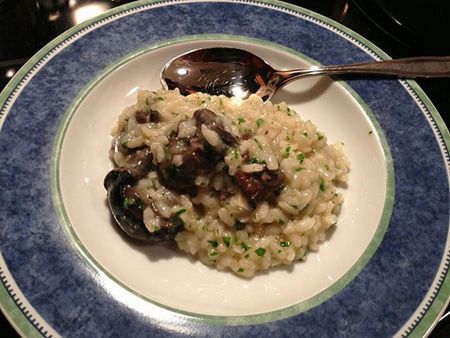
Πιλάφι με σαλιγκάρια
Υλικά:
1 κιλό σαλιγκάρια
1 κρεμμύδι ψιλοκομμένο
2 σκελίδες σκόρδο ψιλοκομμένο
1 φλιτζάνι ρύζι σκληρό κίτρινο
1 φλιτζάνι λάδι
½ κρασοπότηρο λε...
Περισσότερα εδώ: https://elromio.gr/pilafi-saligkaria/
0 notes
Text

Pilaf is proof of divine love tbh
#a bit sticky to really be pilaf since I was more going for porridge lol but didn’t have room for more broth nor patience for more cook time#so it came out more pilafy than porridgey#delicious either way really but yeah#yumepirika rice w cream of mushroom and veggie broth + Cajun seasoning oregano and bay leaf + green onions bell peppers and mushrooms#80% off why I made this was to use up the brown oyster mushrooms since I picked a bit late so they were drying out fast lol#and figured cooking in broth might rehydrate them enough lol which it did they came out great
1 note
·
View note
Text
bored & wanting a more official ‘please take these dragons from me’ post so here we are (with specs!)
[if anyone’s interested, reply/dm (FR user is eroscalling); price for all is 10 coins because i do not care enough, just want people to take them and enjoy them]
1.) icari

— female spiral
— eyes: uncommon arcane
— primary gene: starmap (heather)
— secondary gene: constellation (brick)
— tertiary gene: underbelly (maize)
2.) turlessi

— female spiral
— eye: common arcane
— primary gene: metallic (wisteria)
— secondary gene: butterfly (black)
— tertiary gene: underbelly (lead)
3.) sunon

— male spiral
— eye: common arcane
— primary gene: starmap (carmine)
— secondary gene: butterfly (orca)
— tertiary gene: underbelly (midnight)
4.) picculo

— male nocturne
— eye: uncommon arcane
— primary gene: jaguar (nightshade)
— secondary gene: blend (radioactive)
— tertiary gene: lace (mint)
5.) fortuni

— female skydancer
— eye: unusual arcane
— primary gene: fade (amethyst)
— secondary gene: blend (peach)
— tertiary gene: lace (mint)
6.) pilafi

— male skydancer
— eye: common arcane
— primary gene: fade (periwinkle)
— secondary gene: sludge (fern)
— tertiary gene: lace (jungle)
7.) garlack

— male skydancer
— eye: unusual arcane
— primary gene: fade (midnight)
— secondary gene: blend (banana)
— tertiary gene: lace (thicket)
8.) {unnamed baby}

— male ridgeback
— eye: common arcane
— primary gene: swirl (heather)
— secondary gene: paint (lavender)
— tertiary gene: basic (fern)
#pant rambles#flight rising#the skydancer triplets are the only ones i'd potentially consider keeping#but the desire is not strong enough so if you want PLEASE take them
8 notes
·
View notes
Text
pilaf (n.)
Oriental dish of rice boiled with meat, 1610s, pilau (which remains the commoner form in British English), from Turkish pilav, from Persian pilaw. The form perhaps has been influenced by Modern Greek pilafi, which is from the Turkish word, but Ayto ("Diner's Dictionary") writes that from the beginning "the spelling of the word was positively anarchic" and that pilaf "represents a modern Turkish pronunciation."
A dish made by browning rice in oil and then cooking it with a seasoned broth, to which meat and/or vegetables may be added. From Turkish pilav, from Persian پلاو (pelâv), from Hindi पुलाव (pulāv), from Sanskrit पुलाक (pulāka ‘ball of rice’), which is probably of Dravidian origin.
7 notes
·
View notes
Link
0 notes
Text
Run away
Run away
It is made by mixing rice with a kind of national food and rice in hot water. In some preparation methods, the rice is first fried in a little oil and then turned into a golden color and then boiled in hot water. Palau also includes fried onions, other fried vegetables, spices and more. Fish, meat, pasta, cashews, raisins, etc. can also be added to the palate as per the choice of the locals.
The Balkan, Mediterranean, Kakheshian, Central and South Asian, East African, South American and West Indian islands are home to a variety of foods, such as palau and palau. Afghanistan, Azerbaijan, Armenia, Iran, Uyghur, Uzbekistan, Kazakhstan, Kyrgyzstan, Kurdistan, Crete, Tajikistan, Turkey, Nepal, Pakistan, Bangladesh, Bukhara, Balochistan, India and Swahili.
Naming and retrieval--
"Palau" is pronounced differently in different regions. In Sanskrit, the word pulak means "round of rice". The word is derived from the Hindi word Pulao and the Persian word Polo. The Persian word Pilaw and the Greek word Pilafi (πιλάφι) are derived from the Persian word. The Sanskrit word Pulak may have been derived from a Dravidian word.
History--
The Indian epic Mahabharata has a description of cooking with rice and meat. Ancient Sanskrit compositions such as yajnavalkya memory refer to a dish called "pulau" or "palau". After the conquest of the great Greek emperor Alexander the Great by the Sogdian capital Markand (modern warfare), a royal banquet was held, and Alexander the Great was served palau and other dishes.
A 10th-century Persian scholar, Abu Ali Ibn Sina (Abyssinian), describes a number of foods in a chapter in his medical textbook. He described the various types of pilaf, its preparation methods, the benefits and disadvantages of each ingredient used in pilaf, and so on. So some even call Ibn Sina the father of modern Palau.
Due to the continued use and innovation of the Persian, Arab, Turkish and Armenian peoples, Palau has evolved and is becoming more and more popular in the Mediterranean region. Palau spread to Israel because of the people of the Jewish community of Buara and Persia.
Even during the Commonwealth of Independent States, this Asian food was widely distributed in the Soviet Union. Since then it has been considered a common food in Soviet society.
Local differences
India--
Known as Pulao, Pulaw, Palau, etc., this food has been known in India and South Asia since ancient times. Palau has many other ingredients, including rice, peas, beans, potatoes, carrots, meat, fish, and shrimp. In India, people sometimes enjoy pilaf for lunch or dinner, but pilaf is often cooked at parties and festivals. Palau has high levels of whiteness and affection. Some people like to eat yogurt or raita with palau. Although the biryani looks like palau, the preparation methods of the two are different. In biryani, rice and meat are cooked together and cooked, and a variety of spices are also used. However, the spices are relatively spicy and do not need to be mixed in layers.
Edit your homework
Ingredients: 2 cups of rice, 4 cups of water, 4 cups of carrots, raw peas, capsicum or chilli pepper, 2 teaspoons, 4 teaspoons of oil, 4 teaspoons of ghee, 5 teaspoons of chilli, 1 teaspoon of cinnamon, 2 teaspoons of cashew nuts -10 to 15, ginger-less, hot spices, salt-to-taste preparation method: When oil and ghee are hot, add ginger, chilli, turmeric, cardamom, cinnamon and fry. Raw peas, chopped carrots, chopped beets, etc. are then washed and fried. When the family is fried, fry the rice lightly for 2 to 3 minutes and add water. When the water boils, salt is added to it and the furnace is reduced. Finally, add the cashews, 1 teaspoon of ghee and a little hot spice and close the oven and leave for a while.
0 notes
Text
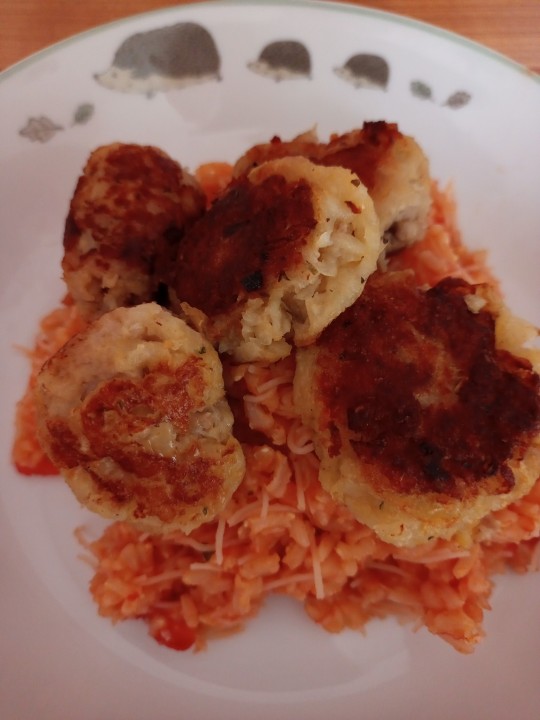
22/8/21 - Food from around the world - Cyprus
Gluten Free Pilafi Pourgouri (replaced the bulhar wheat with rice)
3/5 ***
Would eat again, nice and light, refreshing but nothing amazing.
https://www.thepurplepumpkinblog.co.uk/pilafi-pourgouri-crushed-wheat-pilaf/
Cypriot Meatballs
3/5 ***
Tasty, went well with the Pourgouri, again nothing amazing. Would cook/bake for longer. https://www.therecipehunters.com/cypriotmeatballs
0 notes
Photo
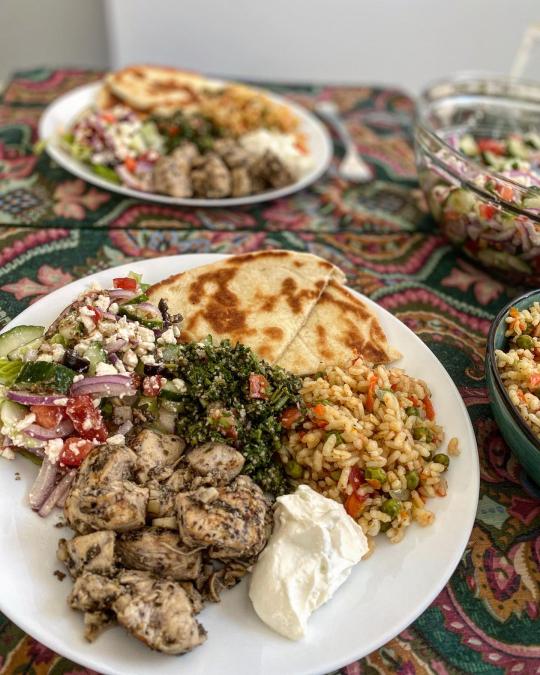
[homemade] Greek Platter with Chicken Souvlaki, Rice Pilafi, Greek Salad, Tabouleh, Naan and Tzatziki
0 notes
Photo

[homemade] Greek Platter with Chicken Souvlaki, Rice Pilafi, Greek Salad, Tabouleh, Naan and Tzatziki via /r/food https://ift.tt/2OZjVzl
0 notes
Text
Oriental Atzem Pilaf Rice by Yiayia Deppy
🍚
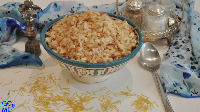
Oriental Atzem Pilaf Rice by Yiayia Deppy – Anatolitiko, Politiko Atzem Pilafi tis Yiayias Deppys
BY: Greek Cooking Made Easy
SUBSCRIBE TO MY YOUTUBE CHANNEL: https://www.youtube.com/greekcookingmadeeasy
Check my YouTube Video: HERE
Κοιτάξτε επίσης την συνταγή μου σε YouTube βίντεο, το λίνκ είναι: ΕΔΩ
youtube
Serves 3-4 persons as side dish
Atzem Pilaf Rice has deep oriental roots, with historical references in Persia. However, officially, it is considered a delicacy from our neighboring country Turkey.
There are many variations to Atzem Pilaf and all are finger-licking delicious.
This is the simplest Atzem Pilaf recipe originated in the old Constantinople (today’s Istanbul) and we love preparing in Greece.
My beloved Yiayia Deppy used to cook this pilaf often when we had a family celebration, since Atzem Pilaf was always considered a special dish. I usually stood next to her and watched her preparing it; sweet memories!! Let’s find out together how she prepared it!
Read more about this dish’s history at the end of my recipe.
INGREDIENTS:
• 1 cup / 225 gr / 7.9 oz Carolina Rice
• 1 tbsp. / 15 ml Butter
• 2 tbsp. / 30 ml Extra Virgin Olive Oil
• 1 medium Onion, finely chopped
• 7.5 tbsp. / 45 gr / 1.6 oz / about 1.3 nests Fine Coiled Vermicelli Pasta (fine fide or fideo pasta, in small pieces)
• 1/2 lt. / 500 ml / 2 cups Beef Broth
• Lemon juice from 1 Lemon
• Ground Salt and Pepper

METHOD:
A. Prepare rice for boiling:
1. Rinse with plenty of cold water the rice, placed in a strainer, until the water comes out clear, so that all its starch is removed.
2. Leave it to drain very well for a while.

3. This process helps rice stay grainy, not sticky and not mushy during and after boiling.
B. Boil the rice:
4. Pour the olive oil in a wide pot over high heat.
5. When it heats up, add the fide pasta and sauté it for a couple min or until it browns, stirring continuously.

6. Next lower the heat to medium and add the strained rice. Sauté it together with the fide for 2’ or until it shines.
7. Then add the chopped onion and sauté it together with the rice and fide too for 2’-3’.

8. Add the broth next and let it come to a boil.
9. Season with Salt and ground Pepper, to taste.
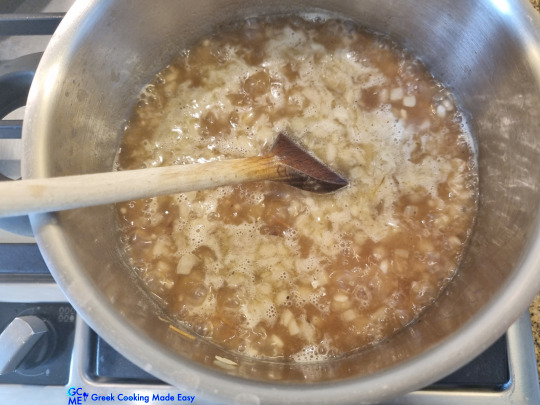
10. Lower the heat. Place the lid on top of the pot and let rice simmer for approx. 10’ – 11’ (depending on the rice quality).
11. Note: Without lid, boiling should take about 20’ and needs probably some extra BOILED water.
12. Atzem Pilaf Rice should be grainy and should stay whole when you eat it.
13. After about 11', rice should be ready. Remove the lid.
14. Just before you turn off the heat, add the butter and lemon juice and stir to mix them in.

15. Remove from heat and cover the pot with a clean kitchen towel. Leave it for 10’-15’, so that the towel will absorb the humidity.
16. Remove towel just before serving.
17. Serve Atzem Pilaf, still hot, in a deep bowl. Look how beautiful and grainy it is!!

C. Serving Suggestions:
Atzem Pilaf is an easy but exceptional pilaf rice that pairs perfectly with any meat or chicken dish you prepare!

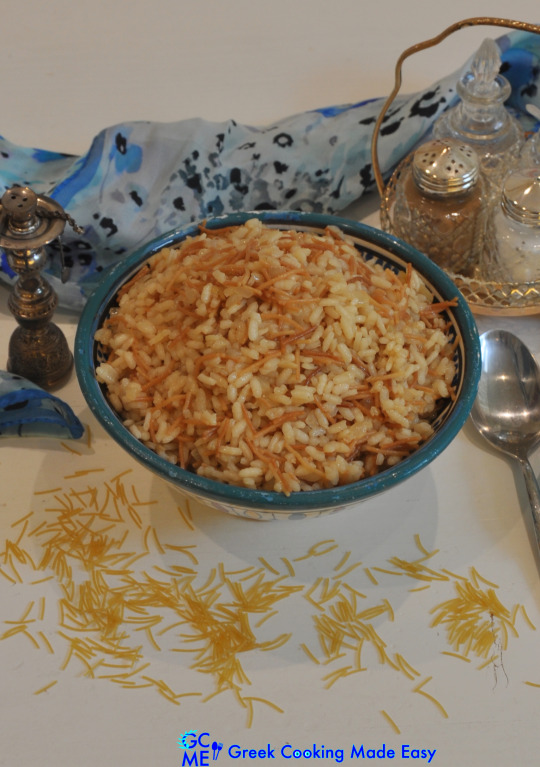
The classic way is, of course, to serve it with Beef Lemonato stew (i.e. in lemon sauce)! Amazing combo!
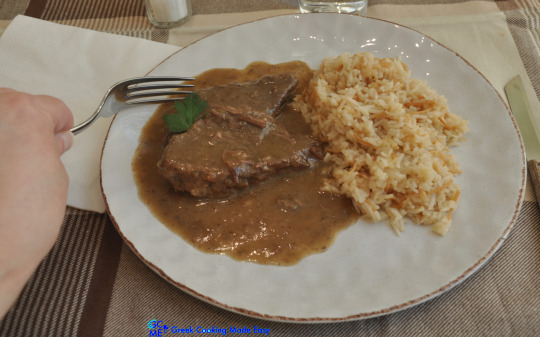
I make it quite often and here I served it with my Mom’s delectable Greek Meatball Burgers-biftekia!!

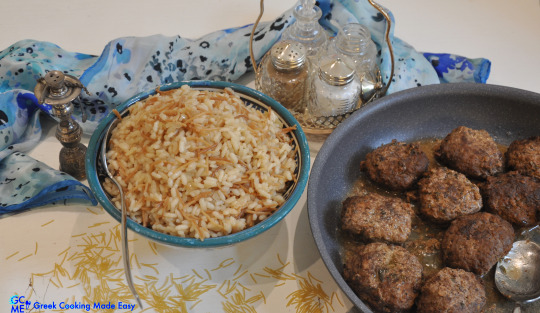
Bon Appetit-Kali Orexi!
Searching for other old Recipes by my beloved Yiayia Deppy? Look HERE

D. Info and history of Atzem Pilaf:
Atzem pilaf has originated in old Persia, since ‘Acem’ were how Persians were called by Turks.
One of the earliest references to pilaf Rice, occurs in one of the histories of Alexander the Great, when he was staying in Persia and a feast was held to celebrate the capture of Samarkand around 330 BC. Even the word pilaf comes from the Persian "pulaw", which in the Turkish language evolved into "pilav". So, Pilaf’s destination of origin is considered to be Iran.

According to the Ottoman version for Atzem Pilaf, which is considered nowadays the most authentic, it was prepared with rice and lamb, cooked with raisins, pine nuts and meat stock. During the Ottoman Empire, it was considered an official food, served at celebrations and weddings.
In the older days in Greece, rice was considered a luxury food. That was mainly because rice was a very rare and expensive ingredient, so to serve it was considered a delicacy and quite special.
In Asia Minor’s Constantinople, they replaced a quantity of rice with vermicelli (or orzo) and this version became one of the most popular dishes in Greece, due to its easy preparation.
Check my YouTube Video: HERE

Ανατολίτικο, Πολίτικο Ατζέμ Πιλάφι της Γιαγιάς Ντέπης
BY: Greek Cooking Made Easy
SUBSCRIBE TO MY YOUTUBE CHANNEL: https://www.youtube.com/greekcookingmadeeasy
Σερβίρει 3-4 άτομα ως συνοδευτικό
Το Ατζέμ Πιλάφι έχει βαθιές ανατολίτικες ρίζες, με ιστορικές αναφορές στην Περσία. Ωστόσο, επίσημα, θεωρείται πιάτο γκουρμέ από τη γειτονική μας Τουρκία.
Υπάρχουν πολλές παραλλαγές για Ατζέμ Πιλάφι και όλες είναι πολύ νόστιμες.
Αυτή είναι η απλούστερη συνταγή για Ατζέμ Πιλάφι που προέρχεται από παλιά από την Κωνσταντινούπολη και μας αρέσει να ετοιμάζουμε στην Ελλάδα.
Η πολυαγαπημένη μου Γιαγιά Ντέπη μαγείρευε συχνά αυτό το πιλάφι όταν είχαμε μια οικογενειακή γιορτή, αφού το Ατζέμ Πιλάφι θεωρούνταν πάντα ένα σπέσιαλ πιάτο. Συνήθως στεκόμουν δίπλα της και την έβλεπα να το ετοιμάζει. Γλυκές αναμνήσεις!! Ελάτε να δούμε μαζί πώς το έφτιαχνε!
Διαβάστε περισσότερα για την ιστορία αυτού του πιάτου στο τέλος της συνταγής μου.
ΣΥΣΤΑΤΙΚΑ:
• 1 φλ. / 225 γρ / 7,9 oz Ρύζι Καρολίνα
• 1 κ.σ. / 15 ml Βούτυρο
• 2 κ.σ. / 30 ml Εξαιρετικό Παρθένο Ελαιόλαδο
• 1 μέτριο, ξερό Κρεμμύδι, ψιλοκομμένο
• 7,5 κ.σ. / 45 γρ / 1,6 oz / περίπου 1,3 φωλιές Φιδές ψιλός, σε μικρά κομμάτια
• 1/2 lt. / 500 ml / 2 φλ. Ζωμός βοδινού κρέατος
• Χυμός λεμονιού από 1 Λεμόνι
• Φρεσκοαλεσμένο αλάτι και πιπέρι

ΜΕΘΟΔΟΣ:
Α. Προετοιμάστε το ρύζι για το βράσιμο:
1. Ξεπλύνετε με άφθονο κρύο νερό το ρύζι, μέσα σε σουρωτήρι, μέχρι το νερό να βγαίνει καθαρό, ώστε να φύγει όλο το άμυλο του.
2. Αφήστε το για λίγο να στραγγίσει πολύ καλά.

3. Αυτή η διαδικασία βοηθά το ρύζι να παραμείνει σπυρωτό, να μη κολλάει και να μη γίνει χυλός κατά τη διάρκεια αλλά και μετά το βράσιμο.
Β. Βράστε το ρύζι:
4. Χύστε το ελαιόλαδο σε μια φαρδιά κατσαρόλα πάνω από δυνατή φωτιά.
5. Μόλις ζεσταθεί, προσθέστε τα κομματάκια φιδέ και σοτάρετε τα για δύο λεπτά ή μέχρι να χρυσίσουν, ανακατεύοντας συνεχώς.

6. Στη συνέχεια χαμηλώστε τη φωτιά στο μέτριο και προσθέστε το στραγγισμένο ρύζι. Σοτάρετε το μαζί με το φιδέ για 2’ ή μέχρι το ρύζι να γυαλίσει!
7. Στη συνέχεια προσθέστε το ψιλοκομμένο κρεμμύδι και σοτάρετε κι αυτό μαζί με το ρύζι και το φιδέ για 2’-3’.

8. Προσθέστε κατόπιν τον ζωμό και αφήστε τον μέχρι να αρχίσει να βράζει.
9. Αλατοπιπερώστε κατά βούληση.

10. Χαμηλώστε τη φωτιά. Βάλτε το καπάκι πάνω από την κατσαρόλα και αφήστε το ρύζι να σιγοβράσει για περίπου 10’ – 11’ (ανάλογα με την ποιότητα του ρυζιού).
11. Σημείωση: Χωρίς καπάκι, το βράσιμο πρέπει να διαρκέσει περίπου 20’ και χρειάζεται πιθανώς επιπλέον καυτό νερό.
12. Το Ατζέμ Πιλάφι πρέπει να είναι σπυρωτό και να παραμένει ολόκληρο όταν το τρώτε.
13. Μετά από περίπου 11', το πιλάφι πρέπει να είναι έτοιμο. Αφαιρέστε το καπάκι.
14. Λίγο πριν σβήσετε τη φωτιά, προσθέστε το βούτυρο και το χυμό λεμονιού και ανακατέψτε να ενσωματωθούν.

15. Αποσύρετε από τη φωτιά και σκεπάστε την κατσαρόλα με μια καθαρή πετσέτα κουζίνας. Αφήστε το έτσι για 10’-15’, ώστε η πετσέτα να απορροφήσει την υγρασία.
16. Αφαιρέστε την πετσέτα λίγο πριν σερβίρετε.
17. Σερβίρετε το Ατζέμ Πιλάφι, ζεστό ακόμα, σε ένα βαθύ μπολ. Κοιτάξτε πόσο όμορφο και σπυρωτό είναι!!

Γ. Προτάσεις σερβιρίσματος:
Το Ατζέμ Πιλάφι είναι ένα εύκολο αλλά εξαιρετικό πιλάφι που συνδυάζεται τέλεια με όποιο κυρίως πιάτο με κρέας ή κοτόπουλο ετοιμάσετε!


Ο κλασικός τρόπος είναι φυσικά να το σερβίρετε με μοσχάρι λεμονάτο! Καταπληκτικός συνδυασμός!

Το φτιάχνω αρκετά συχνά και εδώ το έχω σερβίρει με τα πεντανόστιμα μπιφτέκια της μαμάς μου!!


Καλή σας όρεξη!
Ψάχνετε κι άλλες παλιές Συνταγές της αγαπημένης μου Γιαγιάς?Δείτε ΕΔΩ

Δ. Πληροφορίες για το Ατζέμ Πιλάφι και η ιστορία του:
Το Ατζέμ Πιλάφι προέρχεται από την παλιά Περσία, αφού οι Τούρκοι αποκαλούσαν τους Πέρσες ��Acem».
Μία από τις πρώτες αναφορές στο Πιλάφι, εμφανίζεται σε μια από τις ιστορίες του Μεγάλου Αλεξάνδρου, όταν έμενε στη Περσίας και σερβιρίστηκε πιλάφι σε μια γιορτή για την κατάληψη της Σαμαρκάνδης γύρω στο 330 π.Χ.
Ακόμη και η λέξη πιλάφι προέρχεται από το περσικό «pulaw», που στην τουρκική γλώσσα εξελίχθηκε σε «pilav». Έτσι, η χώρα προέλευσης του πιλαφιού θεωρείται το Ιράν.

Σύμφωνα με την οθωμανική εκδοχή για το Ατζέμ Πιλάφι, που θεωρείται στις μέρες μας και το αυθεντικό, παρασκευαζόταν με ρύζι και αρνί, μαγειρεμένο με σταφίδες, κουκουνάρια και ζωμό κρέατος. Κατά τη διάρκεια της Οθωμανικής Αυτοκρατορίας, θεωρούνταν επίσημο φαγητό, το οποίο σερβιριζόταν σε γιορτές και γάμους.
Τα παλιά χρόνια στην Ελλάδα το ρύζι θεωρούνταν τρόφιμο πολυτελείας. Αυτό συνέβαινε κυρίως επειδή το ρύζι ήταν ένα πολύ σπάνιο και ακριβό συστατικό, οπότε το να το σερβίρεις ήταν μια σπέσιαλ λιχουδιά.
Στη Κωνσταντινούπολη της Μικράς Ασίας είχαν αντικαταστήσει μια ποσότητα ρυζιού με φιδέ (ή κριθαράκι) και αυτή η εκδοχή έγινε ένα από τα πιο δημοφιλή πιάτα στην Ελλάδα, λόγω της εύκολης παρασκευής του.
Κοιτάξτε επίσης την συνταγή μου σε YouTube βίντεο, το λίνκ είναι: ΕΔΩ

#lunch#dinner#rice#pasta#party#children#region#asiaminor#arabic#atzem pilaf#pilaf#pilaf rice#greek recipes#πιλάφι#ατζέμ πιλάφι#ατζεμ πιλαφι#πιλαφι#πολιτικο ατζεμ πιλαφι#deppy#yiayia deppy
1 note
·
View note
Text
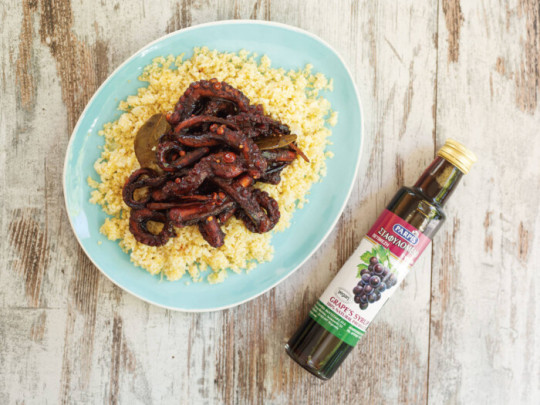
Χταπόδι με έψημα και απλό πουργούρι πιλάφι
ΥΛΙΚΑ
• 1 κιλό χταπόδι
• 200γρ κόκκινο κρασί
• 50γρ ελαιόλαδο
• 60γρ έψημα
• 50γρ κόκκινο ξύδι
• Αλάτι
• 1/2 κουταλάκι τσαγιού μαύρο πιπέρι, ακ...
Περισσότερα εδώ: https://elromio.gr/chtapodi-epsima-aplo-poyrgoyri-pilafi/
0 notes
